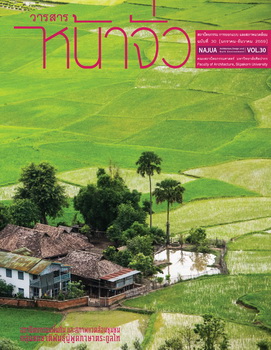พลวัตของสถาปัตยกรรมวัดไทขึน เมืองเชียงตุง รัฐฉาน สาธารณรัฐแห่งสหภาพเมียนมาร์ ในบริบทกระแสโลกาภิวัตน์
Keywords:
พลวัต, ไทขึน, เชียงตุง, Dynamic, Tai Khun, Keng TungAbstract
งานวิจัยนี้มีวัตถุประสงค์มุ่งศึกษาพลวัตของสถาปัตยกรรมวัดไทขึน เมืองเชียงตุง ด้านการเปลี่ยนแปลงทางกายภาพของสถาปัตยกรรม ศึกษากระบวนการ รวมทั้งปัจจัยที่ทำให้เกิดการเปลี่ยนแปลง และการดำรงอยู่ของสถาปัตยกรรมวัดไทขึนในบริบทปัจจุบัน เพื่อให้เกิดความเข้าใจถึงความสัมพันธ์ระหว่างกันของบริบทสังคมวัฒนธรรมกับสถาปัตยกรรมวัดในเมืองเชียงตุง งานวิจัยนี้เป็นงานวิจัยเชิงคุณภาพ ใช้การเก็บข้อมูลภาคเอกสาร และภาคสนาม โดยการสำรวจพื้นที่เพื่อเลือก กรณีศึกษา การสังเกตอย่างมีส่วนร่วม และการสัมภาษณ์เชิงลึกผู้ให้ข้อมูลหลัก ผลการศึกษาพบว่า สถาปัตยกรรมวัดเปลี่ยนแปลงมากตั้งแต่ พ.ศ.2530 เป็นต้นมา โดยมากมีรูปแบบใกล้เคียงกับแบบเดิมก่อนการสร้างใหม่ วิหาร อุโบสถ และเจดีย์จะเปลี่ยนแปลงก่อนอาคารอื่นๆ วัสดุ เทคนิคการก่อสร้างและช่างฝีมือมีผลต่อคุณลักษณะทางกายภาพของอาคารโดยตรง กระบวนการมีทั้งเกิดจากภายใน คือ ชาวบ้าน และองค์กรสงฆ์ของเมืองเชียงตุง กระบวนการภายนอกเกิดจากศรัทธา และเครือข่ายสงฆ์ข้ามพรมแดนมามีส่วนร่วมมากขึ้นภายหลังพม่าเปิดประเทศ ปัจจัยที่ส่งผล ได้แก่ ปัจจัยทางตรง คือ (1) การเสื่อมสภาพของอาคาร (2) การเปลี่ยนแปลงสภาพแวดล้อม และภูมิอากาศ (3) ทรัพยากร (4) วัสดุก่อสร้าง และช่างฝีมือ ปัจจัยทางอ้อม ได้แก่ (1) การเมืองการปกครอง (2) เศรษฐกิจ และ (3) สังคม
Evolution of Tai Khuen Buddhist Architecture in Kengtung, Shan State, Republic of the Union of Myanmar, in the Context of Globalization
Prasong Sang-ngam
Master of Arts in Regional Studies, Faculty of Political Science and Public Administration, Chiangmai University
Surasawasdi Sooksawasdi
Faculty of Fine Art, Chiangmai University
This research focuses on dynamic aspects of Tai Khuen Buddhist architecture in Kengtung with regards to physical changes, the changing process, causes of change, and the role of Buddhist architecture in the present day, so as to understand the relationship between architecture and socio-cultural context. This is a qualitative research carried out by studying from documents and collecting field information through surveys, participation, observation and interviews. The research reveals that Buddhist architecture has changed greatly since 1987 onwards. However, most still bear similar characteristics to the original while the Viharn, Ubosot and Chedi were the first to change. Materials, construction technology and skills have direct effects on architectural appearance of the buildings. The changing process involved villagers and monks organization in Kengtung as well as outside assistance and cross-frontier monks network after Myanmar opened up the country. Causes of change are both direct and indirect. Direct causes are (1) building deterioration, (2) environmental changes, (3) resources, (4) construction materials and expertise. Indirect causes are (1) politics, (2) economics, and (3) social conditions.





